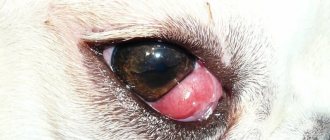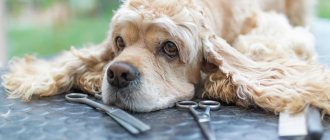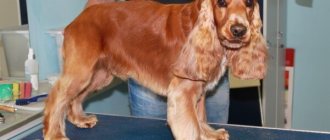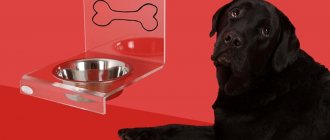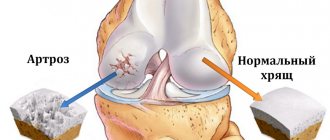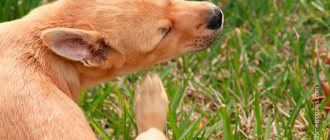Spaniels are the most popular hunting dog today. This friendly creature is ready to walk many kilometers next to its owner through forests and swamps, help drive a duck out of its hiding place and pull shot prey out of the lake. At the same time, the spaniel has good health, which is very important if you are an avid hunter.
However, a spaniel's ears need constant care and attention. If you decide to choose this breed, then prepare some cotton swabs and get ready for a daily inspection. Charming ears are a kind of calling card of this breed, but they create additional difficulties in care.
Prevention is the best cure
The Spaniel's ears first of all need airing. A hanging position contributes to the accumulation of sulfur and the development of various infections. An additional factor is the overgrowing of the ear from the inside with hair. This provides ideal conditions for the development of pathogenic infections.
Therefore, it is recommended to carefully shave or pluck the inside of a spaniel's ears. If the pet is not accustomed to such procedures, then, as a last resort, you can cut the fur short with scissors.
Natural ventilation
There is another preventive measure available. The spaniel's ears can be raised above the head by securing them with a soft clip or hair tie. This is especially true during meals. If you do not do this, after a meal you will have to wash the outer and inner surfaces of the ear, and there is a high probability that water will get inside the auricle. This often leads to inflammatory processes.
Preparing for ear cleaning
With regular cleaning, over time, a kind of “schedule” will be determined; the owner will know over what period the ears become dirty and will be able to eliminate the problem in a timely manner. If the ears become dirty more often than usual, there is a stench, or the dog is bothered by itching, consult a doctor.
When a dog is undergoing treatment, you should act strictly according to the specialist’s instructions, observing the time, sequence of actions and dose of the prescribed medication. Everything is important when it comes to medical prescriptions, because not every dog owner is an expert in veterinary medicine.
How to clean your ears at home
Experts suggest using:
- special lotions - dissolve dirt and earwax. Removed by massaging, with a dry cloth (or by shaking the ears with the dog itself) “ SaniPet”, “Trixie”, “Otifree”, “Ear Cleansing Liquid”, “Nutri-Vet”, “Iv San Bernard CLEAN EAR”, “Chris Christensen MYSTIC EAR" and etc.
Using lotion to clean your ears - an aqueous solution of chlorhexidine is an effective affordable antiseptic
- saline solution (1 liter of boiled water + 1 teaspoon of salt) - antimicrobial effect
- a weak solution of sea salt - will dry out the skin
- calendula , lavender , chamomile flowers will refresh and disinfect
- green tea - wipe the surface of the ear (prevention of inflammation, irritation)
- sanitary napkins for dogs from veterinary pharmacy - specially designed for cleaning ears. Impregnated with a special substance that dissolves dirt deposits and does not irritate the surface of the ear (“ Nutri-Vet ”, “ 8in1 Ear Cleansing Pads ”, etc.)
- special powder for long-eared dogs - dries the inner surface of the ear, improves ventilation, reduces the accumulation of wet dirt (“ Espree EAR POWDER ”, “Hygienic ear powder 8in1 Excel 3 in 1 Ear Powder (USA)”, etc.)
- special oils - used only when there is a large amount of dried dirt that cannot be removed without first softening it
- cotton pads - they are safer than cotton swabs, and even in the hands of an inexperienced, zealous dog owner they will not cause harm
What not to use to clean your ears
It is not recommended to use:
- alcohol or strong saline solutions dry out and cause irritation
- vinegar or hydrogen peroxide - can cause a burn to the mucous membrane if it gets deep into the ear
- popular “Bars” drops and similar medications that are not intended for preventive ear cleaning - you need to read the instructions and use only as prescribed by a doctor
- paper napkins - for soaking - when moistened they fall apart, pieces may remain in the ear
- oil without indications for use - sticks together the villi inside the ear, can cause blockage of the ear canal
- soaps and baby lotions - contain additives that are harmful to dogs and can cause an allergic reaction
- gauze - threads may remain in the ear
- cotton swabs in inexperienced hands can injure the ear and push dirt further
Be careful
When carrying out the procedure, certain precautions should be observed.
Full list of things you should never do:
- hurt the dog
- cause discomfort
- penetrate deeply into the auricle - clean only where you can see
- clean your ears, wipe them daily, rub until they shine - the secretion (sulfur) is released for good reason, it protects the ear canal from dust, dirt, and temperature changes. In its absence, bacteria quickly penetrate inside and begin to multiply
You shouldn't rub your dog's ears until they shine every day. Photo: -Yapster- - brushing a resisting dog by force, holding it tightly - guaranteed stress, negative associations, the reaction will take hold and will get even worse in the future. In addition, when there is resistance to cleaning, microtraumas from rubbing are formed, which leads to the active proliferation of pathogenic microorganisms
- hunt your pet around the house - he will get overexcited and won’t let you touch his ears
- pour alcohol or hydrogen peroxide into the ear - the ear will get burned and dry out
- abuse lotions - it is advisable to use them once every 30 days, since they contain salicylic and benzoic acids, which suppress the growth of all bacteria (both beneficial and pathogenic), which leads to the destruction of natural microflora
- use expired cleaning products that were not stored according to instructions - some people mistakenly believe that what is no longer forbidden for humans can still be done for dogs
On a walk
Representatives of this breed love to walk very much. Active games and exercises in the fresh air strengthen the immune system and normalize the functioning of all organs and systems. A spaniel's ears get very dirty when walking. The dog runs, pressing its curious nose to the ground, and long “canvases” dangle along the ground, collecting dust and microbes.
Coming home, any owner will try to clean his pet. A moistened but not completely washed ear becomes an ideal incubator for bacteria. Therefore, before going outside, make sure to fix your ears high on your head. To do this, you can come up with a headband made of soft elastic. The simplest option would be a piece of nylon stocking. It's quick, cheap, and great for keeping your ears clean.
Breast care during pregnancy and after childbirth
There is no need to specially prepare your breasts for feeding your baby; nature will take care of everything itself. But there are some nuances to care. During pregnancy, you need to wear proper and comfortable underwear. Choose models made from natural dense material, with wide straps and a back, without wires. The underwear should fit the size, not press, but provide good support to the breasts. This way, as the volume of the gland increases, the skin of the breast will not stretch and will retain its elasticity.
It is also recommended to moisturize the breast skin with oils or creams to prevent stretch marks. Of course, you shouldn’t place high hopes on cosmetics, since the main role here is played by the hereditary factor and the individual characteristics of each woman.
You can perform exercises that are allowed during pregnancy on the muscles of the arms and chest. This will improve blood circulation in the mammary glands and strengthen the muscular frame of the chest. Wellness procedures such as contrast showers and light massage, according to the doctor, will not directly affect the shape of the breast, but will improve blood circulation and certainly will not harm.
Also during pregnancy, the specialist advises studying information on how to organize breastfeeding in the maternity hospital and at home. This will help to avoid breast problems during lactation (mastitis, lactostasis), which may negatively affect its shape in the future.
Regular inspection
We have already mentioned that it is necessary to regularly examine the entire ear cavity. Before this, prepare cotton swabs and disks, warm water. Lay your pet on its side and caress it so that it lies quietly during the procedure. Now turn your ear completely inside out and inspect it carefully.
Since cleaning your dog's ears is not difficult, there is no need to contact the veterinarian every time. We offer you a general scheme, following which you can maintain their ideal condition.
When should your dog's ears be cleaned?
Experts recommend regularly examining your pet's ears to avoid any unpleasant surprises in the form of inflammation, otodectosis (ear mites) or a fungal infection. It is clear that prevention is easier and cheaper than treatment.
It is advisable to examine lop-eared and long-haired dogs every other day, straight-eared and short-haired dogs - 1-2 times a week.
Fold-eared breeds often require ear inspection. Photo: Nik Stanbridge
Some doctors talk about daily inspection of “problematic” shells and monitoring the growth of hair inside the ear. Lost and dead hairs can lead to blockage of the ear canal. This can be easily prevented by removing them with pinching movements of your fingers - the dog will be ticklish, but not painful.
It is important to pay attention to changes in the behavior of your four-legged friend. If the dog whines, growls when trying to touch the ears, shakes its head, tilts it to the side, or scratches behind the ears with its paws, an unscheduled examination is needed.
If during inspection you find:
- skin redness
- bad smell
- brown discharge
- scratching behind the ears,
then you have a direct route to the vet.
Your doctor will determine the cause of your dog's ear problems.
The doctor will examine the pet, make an accurate diagnosis and prescribe a course of treatment in accordance with the disease, weight, and condition of the animal. Self-medication or ignoring the problem is fraught with the development of inflammation, including hearing loss or death.
Basic steps
If the inside of the cavity is heavily overgrown with hair, then take nail scissors and cut off all the long hairs, opening the ear canal. Now you can assess the presence of sulfur deposits. If there are few of them, the skin is pale pink, then this time you can do without special cleaning.
How to clean your dog’s ears if you see that a lot of wax has accumulated? In this case, take a cotton pad, lightly moisten it with warm water and squeeze it thoroughly. There is no need to reach deep into the ear with a stick; you only remove what is visible. If in recent days you have noticed that your dog is scratching its ears, it makes sense to use special drops. However, be sure to consult your doctor.
Returning from the hunt
If you often spend time outdoors, then your Cocker Spaniel's ears need more careful care and attention. The most important thing is to prevent moisture from entering the ear canal to minimize the likelihood of inflammation. The working dog swims into lakes and rivers to ensure the supply of game. If we can plug the ear canal with cotton balls while bathing, then the dog should maintain perfect hearing while hunting.
In order to protect the ears, it is recommended to carefully shave the inside of the fur and lubricate the entire skin with sunflower oil. This will prevent water from entering, but does not guarantee 100% protection. Therefore, after the end of the hunt, it is necessary to immediately perform a number of procedures:
- Carefully inspect the fur and ears for the presence of parasites.
- Dry the cavity using cotton balls.
Practical advice
How can the owner determine when to intervene and when the condition of the auricle is completely normal? A hunting dog with long ears is a very beautiful creature, but anatomy suggests that the owner must have certain care skills and know what to do in a given case.
- Open the ear. If the skin inside is pink and slightly warm, then you can finish the preventive examination. Don't forget to praise your pet for its patience.
- The presence of thick brown sulfur is a reason to immediately arm yourself with special napkins or cotton swabs and remove it from the sink.
- If you find blood-sucking insects, it is extremely important to quickly remove them using tweezers. In the summer, especially if you regularly visit the forest, such inspections should be regular.
- If your dog is shaking its ears, this is a warning sign. For the first time, you can pour a little special lotion into your ear and gently massage the auricle. After this, use cotton balls to remove excess liquid. If every time after sleep your dog shakes its ears or scratches them with its paw, be sure to consult a doctor. Perhaps the cause is ear mites.
- It is much worse if the dog has ear pain. This is easy to understand, as the pet loses activity, begins to lie down more, tilts its head low, and groans when trying to scratch or touch its ear.
- Inflammatory diseases, otitis media are very serious, as they can cause complications in the inner ear. As a result, long and complex treatment may be required. Therefore, if your dog has an earache, do not self-medicate, but go straight to the doctor.
Evelina Bledans
Now the domestic star of the 90s has no problem showing off her breasts in photographs. And all because in 2021 Evelina decided to have an operation to enlarge it. Before this, the actress’s bust was of a “non-Hollywood” shape, which is clearly visible in old photographs.
Bledans admitted that she had a lot of complexes because of her atypical bust and envied her colleagues with beautiful breasts. And then I found out that everyone had it done, and without remorse she lay on the surgeon’s table. Well, it happens!
Evelina was lucky, unlike these celebrities: Failed mammoplasty of stars: before and after photos.
Cleaning technique
Speaking about how to clean the ears of a spaniel, it must be emphasized that it is the anatomical features of the breed that give rise to some difficulties. For example, owners of a Rottweiler or a German Shepherd may never know what this procedure means in their entire lives. It is the long ears of short-legged dogs that are the most problematic. However, everything is not so difficult, and with a little practice, you will easily perform all hygiene procedures.
- Caring for your spaniel's ears requires regularity, so first of all you need to teach your pet that this is necessary. Do not catch the animal on purpose; it is better to time this procedure to coincide with moments of affection. When the dog is lying quietly, open the sink and inspect.
- While cleaning, you need to talk to your pet and praise him. This is extremely important to make it easier for you to proceed with the examination in the future, and for this you need to associate hygiene with positive emotions.
- First of all, wet the wet disc and rub it several times along the inner surface. Now you can close your ear and perform a massage. With light movements you will knead your ear, and all dirt and wax will easily dissolve.
- Now you can start cleaning the sink. Wax is usually easily removed with a cotton pad. You can restore order inside the bends using a cotton swab. Usually dogs tolerate massage very well, moreover, it brings them a lot of pleasure.
- If the dog is large, then there is no point in using ear sticks. Just wrap your finger in a strip of gauze, soak it in a special lotion and clean the sink. Remaining dirt can be removed using a special disc.
Proper care of spaniel ears
Long ears are problematic, as they quickly get dirty, and in May-September they become a favorite place for bloodsuckers that abound in the grass.
Excessive moisture on the back side causes inflammation, microcracks and scratches appear.
Dried dirt on the ends pulls the hairs together, thereby injuring the epidermis.
While hunting, the pet runs the risk of hitting the “burdocks” on the sharp protrusions of plants or snags, which causes pain to the poor thing. Severe injury requires urgent medical intervention.
At the same time, keeping the problem area in order is not difficult. Timely and consistent implementation of just a few points is enough to maintain proper condition.
When feeding, it is advisable to raise the ears and secure them above the head with an elastic band made of an elastic material resembling a fabric mesh. This way, the fidget will not be distracted and the “cloths” will not get into the bowl, while remaining immaculately clean.
When feeding, the spaniel's ears must be secured with an elastic band.
Regular inspection
This procedure must be carried out daily upon returning home.
If the mischief maker is incredibly dirty, inspect it superficially to detect wounds and ticks (during the warm season). If there are insects, remove them yourself, or take your pet to a clinic, where specialists will do this. Burrs, blades of grass and other debris are removed by hand.
Some owners, when walking long-eared individuals, put hats and elastic bands on them, saving their ears from contact with asphalt, soil, gravel, etc.
Washing rules
Having visually checked the condition of the problem part upon returning from a walk or hunting, it is recommended to wash the tips of the ears (done at the same time as the paws). Especially if there are clods of dirt, sand, mud, and combing them out will only cause pain.
Small components entangled in the fur are carefully removed, without tearing out the hairs or pulling on the skin.
Then the stained surface is washed with water at room temperature. After which, with light touches, the ears are wrung out and blotted with a towel.
It is not recommended to use a hair dryer to avoid excessive drying.
A complete wash of your furry friend is carried out once a month using shampoos and conditioners for long-haired dogs, which allow you to maintain their original smoothness and shine.
Do not pour water into the ear canal. Causes discomfort and promotes the growth of pathogenic microbes.
When washing, do not allow water to pour into the ear canal.
Before swimming in natural bodies of water, it is advisable to treat the inner surface of the ears, including the ear canal, with vegetable oil, which has a water-repellent effect.
At the end of the water procedure, make sure that the ears are dry, for which they are also raised above the head so that the moisture evaporates. Dipping with cotton balls speeds up drying.
Cleaning and combing
Brushing is just as important as feeding and walking.
Combs and brushes are used. Puppies are accustomed to handling from birth. Initially, babies are placed on their laps. The actions are accompanied by stroking and gentle words so that the baby is not afraid and gradually gets used to it.
For adults, a trimming table is convenient, which greatly simplifies the work of the “stylist”.
If tangles are detected, try to disassemble the matted hairs and remove dead ones, and if there is no positive result, use a tangle cutter.
Before the puppy reaches 5 months, you cannot use combs, since hard teeth damage the delicate skin of babies.
Since wax, dead epithelium, and dirt accumulate in the ear openings, weekly cleaning is required.
To successfully implement the planned event, drip slightly warmed vegetable oil (softens the contents of the ear canal). After a couple of minutes, massage for even distribution.
Wipe the inner surface with a swab dipped in an oil solution with the addition of a small amount of boric alcohol or 3% hydrogen peroxide (chlorhexidine is suitable).
Then clean the holes using a cotton pad or a piece of bandage wrapped around your finger.
Cotton swabs are not advisable. The eardrum is damaged, and the exudate is pushed even deeper. It is difficult to pull it out on your own, which can lead to deafness and inflammation.
The skin of the auditory canal of a healthy ear is smooth, without redness, wounds or suppuration.
There are developed powders, liquids and ear sprays that also eliminate odor.
If dark discharge is visible in the ear and a squelching sound is heard upon palpation, the hearing organ is inflamed (most likely a tick infection). The dog needs to be taken to the clinic for diagnosis and prescription of medications.
A haircut
The hair around the ear canal can be trimmed from puppyhood.
From puppyhood, the hair around the ear canal is trimmed with scissors with rounded ends. To prevent hairs from getting into the passage, it is closed with a piece of cotton wool.
Excess vegetation on the inner surface is plucked out with the thumb and forefingers or non-sharp tweezers.
Approximately two-thirds down from the base of the outer ear (located at eye level) is cut with a dog clipper fitted with a No. 10 attachment. The remainder is trimmed with scissors.
The procedure requires extreme care, since any microscopic cut causes pain and irritates delicate skin.
Need to remember
Each ear uses its own set of cotton pads, sticks and swabs. In addition, after treating one ear, it is advisable to change the solution in which you soaked the discs and wash your hands. This will prevent the infection from transferring from one ear to the other, provided that there is one.
After completing the procedure, be sure to wipe the inner surface of the ear dry and open the shell until completely dry. To do this, it is most convenient to use a mesh elastic band. Simply place it on your dog's head and tuck his ears under it.
The ideal option is to use a special powder after cleaning, which dries the surface well and removes remaining moisture. You can use a small amount of starch instead. But make sure that it does not fall into the ear canal.
The subtleties of raising a puppy
They begin raising the baby immediately after he appears in the house, choosing a day off for this. If you give him a lot of time to adapt, you may miss the time to stop the wrong behavior. In the first days, you can put a heating pad or a small fur mattress in the bed. Under no circumstances should a puppy be placed in a human bed. The puppy is accustomed to its place from the first day of its stay in the new home.
To do this, pat the litter with your hand and say the word “place.” Along with this, the baby begins to accustom himself to his nickname. This is an important step on the path to training, because first the dog must learn to understand when the owner is addressing him. On the very first day, you can wash the puppy so that he can dry and run around until the evening. Then it is washed no more than once a month.
The owner feeds the puppy, he also walks, pets, communicates and plays when the baby requires attention.
There should be no raising of the voice, as well as shouting, in communication and education. The paws and belly are wiped after each walk and washed if necessary so that dirt from the street does not enter the rooms of the house.
It is especially important for the baby to take care so that he does not feel lonely after separation from his mother dog. Call the puppy by name during games, pet it and talk to it. They buy toys for the baby, play with him, while talking to him and calling him by name. As you understand, you can teach the puppy basic commands, such as “no”, “fu”, “come”. In the first months of life, when pronouncing a command, there should be no unnecessary words and huge tirades: the pet simply will not understand what is required of it.
Along with accustoming him to a nickname, his own place and some simple commands, the owner must regularly carry out hygiene procedures. You should not allow the puppy to walk around dirty in the house; you need to clean its ears, comb its fur, and take care of the condition of its teeth. If you teach your child hygiene from childhood, it will become the norm for him, and therefore he will not be nervous during it.
If during play your pet grabs an object with its teeth, you should not pull it out by force.
At first, a dog living in an apartment building will have to be carried for a walk in your arms. Someone uses a backpack for this, and the puppy quickly understands that he is going for a walk as soon as he sees the backpack in the hands of the owner.
Observing the dog's reaction
If your pet behaves calmly or shows signs of pleasure, then everything is going well. You can lightly massage and wipe the sink and let him go for a walk. But if a dog scratches its ears and begins to worry, this may indicate a number of diseases, ranging from mites to an inflammatory process.
Symptoms are usually activated by outside intervention. Therefore, if your pet simply shook his ears and calmly lay down, this is normal; he shook out the remaining lotion or water. If he starts scratching his ears with his claws, then contact a veterinarian.
Lindsey Lohan
Alcohol and drugs ruined not only the actress’s career, but also her health and figure. At 34, Lindsay looks 50: deep wrinkles all over her face, sagging skin, and, of course, sagging breasts.
Regarding the latter, Lindsay repeatedly turned to plastic surgeons in the hope of correcting the situation, but no one helped her. Doctors say: first of all, Lohan needs to give up bad habits, then reconsider her diet, and then we can talk about operations. But, apparently, the former actress does not plan to change her lifestyle.
Use of special means
We deliberately do not name special products for the care of the auricle, as well as for the treatment of diseases of the hearing organs. The fact is that if the dog is healthy, its ears are dry and pink, odorless, and fluid does not flow from them, then the use of any means does not make sense. You can wipe off sulfur and dust with a simple cotton pad moistened with water.
Folk remedies (hydrogen peroxide, potassium permanganate and others) can burn the mucous membrane and cause more problems. They will not help with a serious illness, and are useless for prevention, so their use is a big question.
Special veterinary drugs for combating ear mites, as well as for the treatment of otitis media and inflammatory processes of the hearing organs should be prescribed by the attending physician. Using them at your own discretion is only permissible in an emergency situation when a veterinarian is unavailable and the animal is in severe pain. In all other cases, you must first identify the cause of the disease, and then get a prescription from your doctor.
What actually happens to the breasts during pregnancy and breastfeeding
Obstetrician-gynecologist and lactation consultant Alina Gritskevich says that under the influence of hormones during pregnancy, the ratio of glandular and adipose tissue in the breast changes. The glandular tissue that produces milk grows. It partially replaces the adipose tissue that predominates in a woman’s non-pregnant breast and determines its shape and volume.
- Immediately after childbirth, the process of milk production begins. At first, a woman’s breasts look full and elastic due to the fact that milk arrives in the glandular tissue and the lactation process is established. By about 3 months of age, the breasts adapt and produce as much milk as the baby needs - lactation becomes mature. The breasts become soft and do not fill out as before.
As the baby gets older, breastfeeding patterns change. Usually, after a year, the number of feedings decreases, the amount of milk decreases, it changes in composition, and becomes “concentrated.” As a result, the reverse process begins in the mammary gland: glandular tissue begins to be replaced by fatty tissue. This occurs within 1.5-3 years after birth. At this time, the skin of the breast gradually tightens due to its elasticity.
Ear scabies
Ear scabies in dogs, or otodecosis, is a common disease that is caused by extremely unpleasant and harmful parasites. They settle on the inner surface of the auricle and in the ear canal. They feed on blood and particles of the epidermis. A few mites caught in a dog's ear cause only minor itching. But the colony grows, the animal begins to shake its head, rub its head against corners, scratch its ears with its claws, tearing them until they bleed. Permanent wounds and ulcers gradually form in the ear area.
The advanced form of this disease leads to damage to the eardrum, meningitis (inflammation of the membranes of the spinal cord and brain) and arachnoiditis (inflammation of the arachnoid and pia mater of the brain). Before treating your pet, you need to make a correct diagnosis. If the problem is only in the ear mite, then it can be dealt with using special drops “Otibiovin”, “Mastiet-Forte”, “Tera-delta”, “Aurikan” or “Otovedin”.
Common diseases
Due to the structure of the Cocker Spaniel's ears, high humidity remains underneath them, which leads to the accumulation of bacteria, the development of fungus and other infectious diseases.
The owner should be alert to the following symptoms:
- the animal is worried during the cleaning procedure, scratches one or both ears, rubs them with its paws;
- unpleasant odor from the ear canal;
- tilting the head to one side;
- yellow, mahogany, or brown discharge from the ears;
- rash, redness;
- pain on palpation;
- hearing impairment.
These or similar symptoms should cause concern to the owner. If you do not seek veterinary help in time and do not start treatment, this can lead to complications including complete hearing loss.
Inflammation of the middle ear, or otitis media, is a disease to which spaniels are more susceptible to dogs of other breeds. The cause may be a bite from a blood-sucking insect, cold water getting into the ear canal, an allergy, or a fungus. Treatment consists of treating the inside with a 2% solution of salicylic alcohol or a 3% alcohol solution of boric acid. For puppies, a more gentle saline solution is used.
For complex treatment, antibiotics or antiseptics are used.
If otitis is of an allergic nature, first of all the allergen is excluded and antihistamines are prescribed.
Sometimes other diseases develop against the background of otitis: tonsillitis, conjunctivitis, rhinitis, fever appears, and the animal loses activity and appetite. In this case, treatment is enhanced with hormonal agents and novocaine blockades.
Ear mites (otodectosis)
10% of ear diseases in dogs of this breed are caused by the Otodectescynotis mite, an insect the size of a pinhead. Parasites live primarily in the ear canals. Ear mites are highly contagious to dogs and other pets, but are harmless to humans.
Treatment is carried out with antiparasitic agents as prescribed by a veterinarian. Therapy will take at least three weeks - as long as the insect's life cycle lasts. During this period, all parasites are destroyed, even those newly hatched from the larvae.
Due to weakened immunity, otodectosis is often accompanied by a complication - a secondary bacterial or fungal infection. In this case, the dog must be prescribed antibiotics and antifungal agents. For severe itching that accompanies this disease, hormonal medications are prescribed.
Foreign body
During the examination, the owner may find seeds or awns of herbs or small insects in the pet's ear. They must be removed using long tweezers. If your dog experiences pain, contact your veterinarian, who will administer short-term anesthesia during the procedure.
Injuries
Spaniels are active dogs, natural hunters and often injure their ears.
It is important to treat even small wounds in a timely manner, otherwise the animal faces inflammation. After an injury, a hematoma may occur between cartilage and skin (on the outer surface) or between cartilage and perichondrium (on the inner surface).
The auricle swells, thickens, and the ear loses its elasticity.
Before opening the hematoma, a tight bandage is applied to the animal’s head for 5-6 days. After the operation, for another 10-12 days, the spaniel will have to apply a healing ointment and bandage the head, wrapping the sore ear around the head.
Otitis in dogs
As we have already said, ear mites can lead to the development of inflammatory processes in the ears, that is, otitis media. However, inflammation of the ear canal can lead to overgrowth of the ear canal. In this case, surgery is required; medications will not help in this case.
Allergic otitis media is another common cause. There are breeds that are more prone to allergies, but it can happen to any dog. In this case, the veterinarian relieves inflammation with antibiotics and prescribes antihistamines.
A tumor in the ear canal is another cause of inflammation. But the list does not end there. The cause of otitis may be a foreign body entering the ear or hormonal imbalance, water entering the ear.
Treatment of otitis media
Having noticed the first signs of otitis, you should urgently contact a veterinarian, who will make an accurate diagnosis and prescribe the necessary course of treatment. Otitis can be of various types.
- Purulent. Pus flows from the animal’s ears, and in the chronic stage, ulcers and holes appear in the eardrums. For treatment, strong antibiotics are used, and the dog’s ears are also washed with hydrogen peroxide and chlorhexidine.
- Chronic. This otitis media is caused by staphylococcal and streptococcal bacteria. Pseudomonas aeruginosa and Escherichia coli can also be causative agents of the disease. Only a veterinarian can accurately determine the dog’s condition and prescribe the necessary treatment. Usually the doctor prescribes a course of strong antibiotics together with compresses of Dexamethasone solution and Otospectrin drops.
- Outer. The hair follicle becomes inflamed or the disease is caused by bacterial and fungal infections. It can manifest as eczema, ulcers, itching and inflammation of the ears. Oridermil ointment is usually prescribed for treatment.
- Fungal (otomycosis). The inflamed epidermis does not fulfill its protective functions, and the fungus provokes the appearance of a dangerous infection. A lot of wax is released from the ears, accompanied by severe itching. The dog's ears become red, inflamed, swollen, pus appears and there is a foul odor. Phosphoric acid and Gazelan 2% are prescribed for treatment.
- Bacterial. This type of otitis media is accompanied by severe itching. It can affect either one ear of the animal or both at once. The ears discharge pus, become very red, and have a foul odor. Surolan drops are usually prescribed for treatment.
- Allergic. It may occur as a result of allergies or due to hormonal imbalances. Earwax is released abundantly from the ears, and active proliferation of mycoses is also observed. The dog begins to scratch its ears vigorously, resulting in ulcers and purulent discharge. It is necessary to show the dog to a veterinarian and possibly change the diet by replacing food, which can cause allergic reactions.

